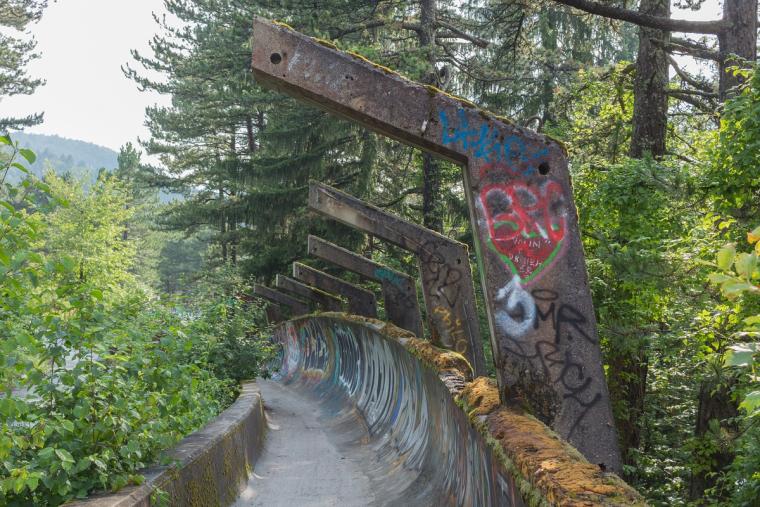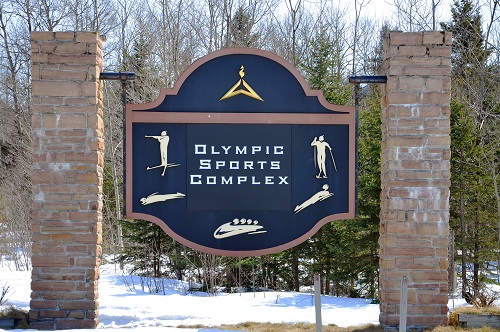
Prior to rebuilding, the former Olympic bobsled track in Sarajevo was a target for vandalism.
In June, the New Yok State Olympic Regional Development Authority reintroduced the Lake Placid Legacy Sites Passport, which includes one-time admissions to four venues used during the 1980 Winter Olympic Games. The continued operation of those sites — Whiteface Mountain, Mt Van Hoevenberg, the Olympic Jumping Complex and the Olympic Center — helped generate $25 million in state and local tax revenue during the 2022-23 fiscal year, according to the Olympic Authority.
Over the past six years, the organization has undertaken significant rejuvenation and modernization efforts for each venue, elevating them to world-class competition standards while enhancing the overall experience for recreational athletes and casual tourists, officials say. With year-round attractions, meeting spaces at each venue and a full-service convention center in downtown Lake Placid, the Olympic Authority has expanded its appeal to a wide range of visitors.
Lake Placid’s success story is part of the “legacy” on which the International Olympic Committee has recently placed a greater emphasis. In 2022, the IOC released a report indicating that 92% of permanent venues used for the Summer and Winter Games in the 21st century — and 85% of all permanent Olympic venues since the Games began – remain in use.
Of the 15% of permanent venues not in use, the majority were unbuilt or demolished for a variety of reasons, the IOC noted. Some reached their end of life, some were destroyed during a period of war or in accidents, and others gave way to new urban development projects. Only 35 venues — or 4% of all 817 permanent venues — are closed, inactive or abandoned.
Titled “Over 125 Years of Olympic Venues: Post-Games Use,” the report serves as the first official inventory of post-Games use of 817 permanent and 106 temporary Olympic venues across 51 Olympiads — from Athens, Greece, in 1896 to PyeongChang, South Korea, in 2018, according to the IOC. (The report was compiled through data collection and wide stakeholder consultation, including venue owners/operators, legacy entities, city/regional governments and National Olympic Committees, and it was assured by the third party KPMG according to the audit standard ISAE 3000.)
“This report is a very impressive testimony to the legacy that the Olympic Games create in the host cities and regions,” Christophe Dubi, the IOC’s Olympic Games executive director, said in a statement issued at the time of the report’s publication. “We are thrilled to see that the overwhelming majority of Olympic venues continue to offer sports competition and training opportunities at elite and grassroots levels, while creating health and social benefits in past Olympic hosts. With the IOC’s focus on sustainability and legacy, the lessons from the past are more important than ever. By looking at the post-Games trajectory of Olympic venues, we wanted to better understand the likelihood of their continued use. This will help us ensure that future Olympic Games continue to create even more sustainable legacies for their hosts, responding to their long-term sustainable development needs.”
“Olympic hosts now have more flexibility to design the Games so that they meet the long-term development plans of a city or region,” added Marie Sallois, the IOC’s director for corporate and sustainable development. “Today, it is the Games that adapt to their host and not the other way around.”

Here are highlights of how some former host cities have maintained the legacy of their Olympic venues:
• Lake Placid, N.Y. (1980 Winter Olympics): The mile-long luge, bobsled and skeleton track at the Mt Van Hoevenberg Sliding Center will host the 2025 International Bobsleigh and Skeleton Federation World Championships, and it is home to several national events. The newly modernized facility also includes a world-class Nordic Center with 55 kilometers of cross-country skiing trails. Mt Van Hoevenberg and Whiteface Mountain hosted the 2023 NCAA Skiing Championships, too.
• Los Angeles, Calif. (1932 and 1984 Summer Olympics): Memorial Coliseum, site of the Opening and Closing Ceremonies as well as track and field events for both Summer Games, also has hosted two Super Bowls and four U.S. Olympic track and field trials. It will host more Olympic events when the Summer Games return to Los Angeles in 2028.
• Sarajevo, Yugoslavia (1984 Winter Olympics): Olympic Hall, later renamed Juan Antonio Samaranch Olympic Hall, was rebuilt after civil war in the 1990s and offers a range of sports and cultural activities. According to the IOC, local community members play up to 17 different sports there — from tennis and football to skating, bowling and pistol shooting. The venue also hosts concerts, trade shows and conferences.
• Lillehammer, Norway (1994 Winter Olympics): Host to the biathlon, cross-country skiing and Nordic combined competitions, the Birkebeineren Ski Stadium’s cross-country trails and biathlon trails are still used extensively. They have welcomed several FIS Cross-Country World Cup, Biathlon World Cup and Nordic Combined World Cup events, and during the summer, the trails are popular with walkers, joggers and mountain bikers.
• London, England (2012 Summer Olympics): The London Aquatics Centre was reconfigured after the Games to ensure its long-term use and sustainability. Today, the venue is widely used by the community for sports and recreation. More than 50 schools have lessons there, according to the IOC, and an estimated 3,500 swimmers and 600 divers visit the facility every week.
On the other hand, officials in Brazil have struggled to make good on the legacy promises of the 2016 Rio de Janeiro Summer Games. “The four park venues administered by Brazil’s Citizenship Ministry host occasional competitions, like the Pan American Gymnastics Championship,” the Associated Press noted in 2021. “Few cyclists use the velodrome’s Siberian pinewood floor to train, and Brazil didn’t field a single competitor for Tokyo, despite promises the facility would be an incubator. … At the Olympic Park’s broad, striped outdoor walkway — where in 2016 tens of thousands of fans cheered — [there is] silence, and no shade from the scathing sun. There are no bathrooms, drinking fountains nor food providers outside, either, making it inhospitable to visitors.”
Medium.com put together a collection of devastating photos of Rio’s venues in disrepair a mere six months after the Closing Ceremonies.
But in March of this year, “[w]orkers began carefully dismantling the Handball Arena in the Olympic Park, the vast area that in 2016 hosted 16 Olympic events and 10 Paralympic ones, including tennis, cycling [and] swimming,” according to Reuters. The venue’s equipment, such as lifts and air conditioning units, will be repurposed for use in four state schools that will be built near where several Olympic events took place.
“All these Olympic structures were conceived to be easy to dismantle so that part, not all, of the material could be used to construct public schools," Rio Mayor Eduardo Paes said. "It’s the first step in executing our Olympic Legacy Plan that was sidelined over the last few years."

